Is there a way to achieve this in Pandas?
Sample of my dataset:
date_time version_A spend_A version_B spend_B
2022-07-30 User1 39734.582 User1 15354.253
2022-07-30 User2 11720.6742 User2 3486.8551
2022-07-30 User3 49015.5171 User3 18384.4266
2022-07-30 User4 23715.6717 User4 7944.3769
2022-07-30 User5 84249.8283 User5 47160.7129
... ... ... ... ...
2022-08-12 User1 20033.313 User1 8494.045
2022-08-12 User2 6045.3053 User2 2647.7135
2022-08-12 User3 30325.7474 User3 14720.9046
2022-08-12 User4 12838.4424 User4 12957.7918
2022-08-12 User5 111739.7095 User5 39797.8841
70 rows, 4 columns
On the x-axis I want the date_time, and for each x I have about two groups of 5 users each and I want to represent them as stacked bar chart.
I dropped column version_B then I tried grouping the data then plotting using this:
df.groupby(['version_a', pd.Grouper(freq='D')])['spend_a','spend_b'].sum().plot(kind='bar')
Which gives me a chart which is not decipherable.

Essentially, I want those two columns to be side by side but they should be stacked in way that the bar is made up of the values on version_a with different colors.
Adding the option 'stacked' in plot() just stacks spend_a and spend_b which is not desired.
Any ideas?
EDIT: I found a partial solution for my problem: How to create a yearly bar plot grouped by months
df= pd.pivot_table(data=df, index=df.date_time_p1,
columns='version_B', values=['spend_A', 'spend_B'])
df.plot(kind='bar', figsize=(12, 4))
spend_A spend_B
version_A User1 User2 User3 User4 User5 User1 User2 User3 User4 User5
date_time
2022-07-30 119203.746 35162.0226 147046.5513 71147.0151 252749.4849 46062.759 10460.5653 55153.2798 23833.1307 141482.1387
2022-07-31 148194.771 46108.4352 195859.2123 136879.6758 433808.2329 54256.947 14023.0875 64238.7360 28703.0427 170297.5719
2022-08-01 154753.638 53772.0705 210497.8440 106826.5884 576303.9486 69089.559 17719.4886 67811.4348 26345.3781 220058.0895
2022-08-02 186336.963 67005.9321 383711.2353 91320.3990 551705.8338 168215.307 26589.2934 104063.0493 27809.8809 311763.5661
2022-08-03 28730.260 16887.6110 46366.1278 13737.8429 115621.7331 11571.692 5597.1872 15497.5675 6375.6251 83798.0708
But I still can't figure out a way to stack spend_A and spend_B as two separate columns. Using plot(stacked='True') groups everything into a single column.

